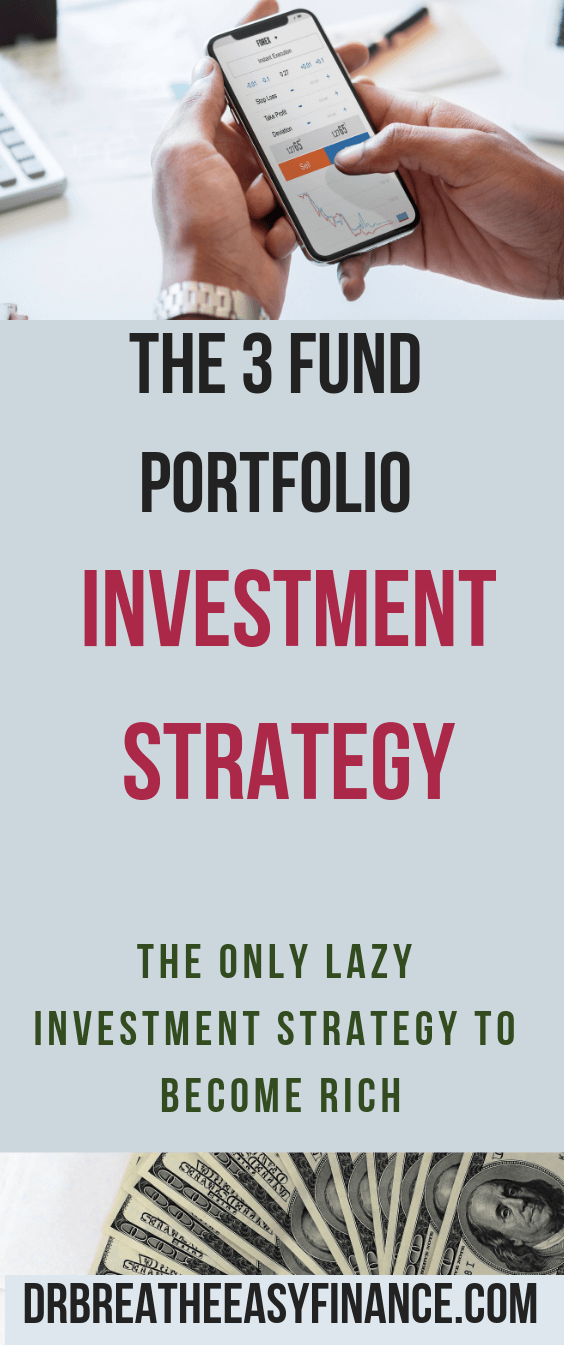Investing in and of itself can be a mind-boggling complication. The options of investment choices are nearly endless and the opinions of each so-called “investment expert” seem to change on a weekly basis…until the introduction to the 3-fund portfolio investment strategy.
The 3-fund portfolio investment strategy may just be your answer to growing your wealth and protecting yourself against potential losses.
The great thing about it is that it’s so simple that even beginning investors can start following the strategy.
What is the 3-fund portfolio and how does it work? Consider this your complete guide to understanding the three-fund portfolio investment strategy.
Table of Contents
The 3 Fund Portfolio
Believe it or not, the 3-fund portfolio is much simpler than you may be thinking. Too many people have lost too much money trying to place the best stock picks, predict market trends, time market movements and even outperform market expectations. With the 3-fund portfolio, all of this goes right out the window.
The 3-fund portfolio consists of investing in 3 asset classes:
- US Stocks
- US Bonds
- International Stocks
Since I use Vanguard, this is the three core funds in that portfolio
- Vanguard Total Stock Market Index Fund (VTSAX)
- Vanguard Total International Stock Index Fund (VTIAX)
- Vanguard Total Bond Market Fund (VBTLX)
This strategy takes an already complicated topic, investing, and simplifies it to its absolute bare minimums.
Even Albert Einstein himself said, “Everything should be made as simple as possible, but not simpler.”
Even Albert Einstein himself said, “Everything should be made as simple as possible, but not simpler.” Share on X
Why US Stocks, US Bonds & International Stocks?
You may be asking yourself why the three among all the potential asset classes? The simple answer is diversification and hedging against losses. By diversifying your portfolio into multiple asset classes, you lower the risk of loss.
When US stocks are taking a beating, chances are that your portfolio of bonds and international stocks may make up the potential losses, and vice versa.
This concept is also referred to as “hedging against losses.” The three asset classes combined allow one to take advantage of the growth of thriving companies both in the US and internationally while taking advantage of a fixed income portfolio should the stock market become bearish.
Check out our post on how to survive the bear market, and how to be sane during a downturn of the stock market. The analogy is priceless – the encounter of a real bear encounter in the wild.
What investments are used within the 3 funds?
Within the three asset classes of the 3-fund portfolio are potentially more hundreds of thousands of investment choices. Remember, the 3-fund portfolio is based on simplicity, and simple we are going to keep it.
The strategy suggests investing in low-cost index funds that track the overall performance of each asset class.
Choosing an index fund that tracks the performance of the total US stock market, the total US bond market, and the total international stock market.
Index funds generally have much lower fund fees while giving access to the broadest form of diversification.
It’s taking the ultimate simplification and combining it with the ultimate diversification to give you the ultimate long-term top performing investment portfolio.
What is an index fund?
Index funds are a form of passively managed mutual funds that track the performance of a particular market or market segment.
A passively managed mutual fund is a fund that does not have active fund managers working to invest in vehicles they believe will outperform the stock market.
Because an index fund consists of a large variety of stocks of a particular market or segment, it is not required that the fund is “actively managed”, but passively track that particular market.
An example of an index fund would be a fund that tracks the S&P 500 index.
A company may create a fund that consists of all the companies included in the S&P 500, and thus they can passively manage this fund by simply mimicking the portfolio of the S&P 500.
The 3-fund strategy invests in index funds that track the entire market of each segment fund segment; the total US stock market, the total US bond market, and the total international stock market.
Check out the modern portfolio theory to understand better.
Why index funds?
Index funds are simple in nature, which fits this investment strategy perfectly.
You may be familiar with working with a professional who suggests specific stocks or funds to invest in, yet to find their investment prediction went south.
Index funds will match the entire market index that they are tracking, taking the guessing game out of the equation.
Investing with index funds also allow you to take advantage of the overall market return which history shows us is much better than the average investor trying to time the market.
To top things off, with the nature of index funds being a passively managed fund, it requires less management which equals lower fees. Depending on the size of your portfolio, this can potentially mean huge differences in your overall returns.
PIN IMAGE – TAKES FEW SECONDS

Why use the 3-fund portfolio?
Despite the fact that this investment strategy is easy enough for even the beginner investors to follow, yet diversified enough that it outperforms most expert investors, there are a few important reasons the 3-fund portfolio is a home run investment strategy:
- It gives you complete investment diversification
- Total market performance on average outperforms the majority of wealth managers and other investment professionals
- It’s more cost effective
- It’s “…as simple as possible, but not simpler.” (Albert Einstein)
Diversification
A nylon rope is made up of hundreds or even thousands of smaller strands of nylon string, woven together to make a rope. The strength is found in the combining power of all the smaller strands of nylon.
If we were to take that same nylon rope and use just one strand of the many nylon strings to rely on, I think we could all agree that the small string alone isn’t strong enough in almost any circumstance.
This same concept, when applied to investing is known as diversification. Rather than relying on just one stock pick, or even a handful of potential stock companies as investments, diversification allows your portfolio returns to be dependent upon the overall performance of all the companies combined.
If one company is weak, your portfolio is strengthened by the other hundreds or thousands of potentially stronger companies. The end result is expert investment returns.
Performance
When taken the average returns of the US stock market over the last 50 years, year over year average growth is about 10%. Take that over a shorter time frame of the last 10 years and the average is just under 7%. 7 -8% is the generally accepted return rate most financial people use.
In other words, by investing in the market as a whole, your returns are better than the majority of nearly all investors. This same concept applies to the modest returns of the total US bond market and the total international stock market.
Cost
Take, for example, the average cost of an actively managed mutual fund and compare it to the cost of an index fund. An average example of an actively managed mutual funds may cost approximately 0.8% annual expense ratio, and an index fund may cost 0.1% annual expense ratio (sometimes lower). That’s 8 times cheaper overall just by using index funds. A good article by NerdWallet showed how 1% fee could cost millennials $590,000 in retirement savings. Poof!
Why is this? Again, index funds are passively managed. They simply match the overall market of a particular index or market segment, in this case, the total US stock market, bond market, and international stock markets.
Although this small amount may not seem like much up front if you’re just starting to invest, it adds up over the years and the principle of compound interest kicks in. If you’re investing larger amounts, then the difference in expense ratios will have you shouting from the rooftops in the money you save!
You can play around with our compound interest calculator to see for yourself.
Simplicity Plus Diversification
Diversification alone can be a complicated concept, but by following the 3-fund portfolio strategy, it simplifies the strategy and gives you access to the ultimate diversification strategy. By investing in these three market segments, using just low-cost index funds, your investment portfolio suddenly becomes much easier to manage.
In fact, you don’t even need to hire a wealth manager or financial advisor to help out! And on the other hand, your portfolio will be even more well-rounded and better performing than investors working with a costly professional.
To add to our famous quotes on simplicity, Leonardo da Vinci stated that “Simplicity is the ultimate sophistication.” It’s almost as if Leonardo was talking about the 3-fund portfolio…
Leonardo da Vinci stated that “Simplicity is the ultimate sophistication.” It’s almost as if Leonardo was talking about the 3-fund portfolio... Share on X
How To Get Started Using The 3 Fund Portfolio Strategy
Getting started with the 3-fund portfolio doesn’t take the help of an investment expert.
Simply open up an investment brokerage account with a reputable investment bank, pick the three index funds you wish to choose that track the 3 funds discussed (the total US stock market, the total US bond market, and the total international stock market), and begin investing for the long term.
There are potentially hundreds of index funds that all track the overall markets from the 3-fund portfolio strategy.
The difference is hardly noticeable since they all track the same markets. Think of it like choosing which bank to open a bank account.
Most checking and savings accounts are fairly the same, it’s just a different company providing you access to it.
With index funds, the main differences will be the expense ratios you see that different companies may charge.
Often times, when opening up your investment bank account, your investment bank may provide you access to free trades if you use their company index funds.
Regardless of your investing experience, the 3-fund investment portfolio strategy combines all the top professional advice, strategies, diversification, and combine’s them all into one simplified easy way to manage your portfolio.
Stick to it for the long run and your friends and family will be coming to you for investment advice when they see your portfolio performance.
If you want to explore a little, I have added one more fund to our portfolio. We now use the lazy 4 fund portfolio.
What do you think? Is the 3 fund portfolio too simple for you? Please comment below.
To start investing, you have to budget to save money first.
Have you taken care of your life and disability insurance?
Are you a physician and you want to negotiate your contract to get the money you deserve? If you need help, check out our sponsor page.
I am a pulmonary and critical care doctor by day and personal finance blogger/debt slaying ninja by night.
After paying off close to $300,000 in student loan debt in less than 6 months into my real job, I started on a mission to help others achieve the same. There is no magic to this than to strap up and get it done. Some of the ways we achieved this include side hustle, budgeting, great negotiation skills, and geographical arbitrage.
When I was growing up, common knowledge in Nigeria is that there is one thing you cannot trust anyone else with, and you guessed it – your money.
Being frugal came easily to me based on my background. However, the concept of building wealth did not solidify in my mind until when I finished medical school. I wish I knew what I know now when I was 14. Still, I don’t know enough and I am constantly learning to improve my knowledge.
My goal is to reduce financial illiteracy among young professionals. I am catering to the beginners – babies and toddlers in financial literacy.








xrayvsn says
I started out with the 3 fund portfolio courtesy of the Bogleheads. I then added the Vanguard REIT fund to add some real estate into the mix because I thought it was a good way to get yield far greater than the low rate I was getting from the bonds (so I decreased the percentage of bonds in my folder). I know Gasem is not a big fan of the 3 fund (the international part) and has done posts where you can get better return/risk ratio with just 2 fund. I don’t think you can go wrong with any of these approaches as long as you stay the course and do low cost.
Kpeds says
Nice back to basics post. I like the way you outlined the explanation of the 3 fund portfolio. I gave a talk to some medical students the other day introducing some of these exact ideas. I’m going to have to reorganize it a bit!
wealthydocmd says
Sometimes simpler is better. This is one of those areas. 1-3 funds are all that is needed to get optimal returns from financial markets.
We have Jack Bogle to thank for that.
If you think you can outsmart the market over time after expenses and taxes you likely just haven’t kept good records. Or maybe you are in a lucky 2%. Give it time, and the market will take back the return. I used to try to pick the timing and the stocks. I had to learn these basic lessons the hard way. I hope readers will not make the same mistakes I made and that others continue to make.
Buy entire markets with index funds and forget the rest.